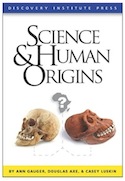 Evolution
Evolution
 Faith & Science
Faith & Science
A Veil Is Drawn Over Our Origin as Human Beings
 Darwinists and creationists, rivalrous twins in many ways, would like it to be otherwise, yet a veil is drawn over our origins as human beings. That’s the simplest summary of Science and Human Origins, the new book from Discovery Institute Press.
Darwinists and creationists, rivalrous twins in many ways, would like it to be otherwise, yet a veil is drawn over our origins as human beings. That’s the simplest summary of Science and Human Origins, the new book from Discovery Institute Press.
On the intelligent-design side of the evolution debate, we have made our peace with a certain agnosticism. From the scientific evidence, it is stubbornly uncertain how the first humans arose, whether from a lineage including ape-like creatures and far humbler ancestors or not.
This is in contrast to the insistence of theistic evolutionists like Kenneth Miller and Francis Collins. As Casey Luskin points out in Chapter 4, “Francis Collins, Junk DNA and Chromosomal Fusion,” Miller and Collins speak about human-chimp cousinship as having been demonstrated by “case-closed” evidence, “leading inexorably” to a “virtually inescapable” conclusion of common ancestry.
But it’s not so. The evidence from chromosomal fusion, for one, is strikingly ambiguous. In the Darwinian presentation, the fact that humans possess 23 chromosome pairs and great apes 24 clearly points to an event in which human chromosome 2 formed from a fusion, leaving in its wake the telltale sign of telomeric DNA — normally appearing as a protective cap at the end of the chromosome — in the middle where it doesn’t belong. Ergo, common descent.
But Casey explains, there’s a lot wrong with this inference. Even if there was such an event and humans once had 24 chromosome pairs, it doesn’t at all follow that this happened in some prehuman past. Nothing stands in the way of picturing a human population bottleneck accomplishing the spread of a fused chromosome 2 from part of an early human community to all of it.
But the idea of such an event having occurred at all is itself far from sure. The telomeric DNA parked in the middle of chromosome 2 is not a unique phenomenon. Other mammals have it too, across their own genomes. Even if it were unique, there’s much less of it than you would expect from the amalgamation of two telomeres. Finally, it appears in a “degenerate,” “highly diverged” form that should not be the case if the joining happened in the recent past, circa 6 million years ago, as the Darwinian interpretation holds.
Luskin concludes:
Unlike proponents of Darwinian evolution, intelligent-design theorists are not obligated to accept human/ape common ancestry as a given. They are free to follow the evidence wherever it leads.
Why it leads to ambiguity is a good question, another one that science probably cannot answer. As the adage says, “Teach your tongue to say, ‘I don’t know.'”
On the weighty matter of human self-definition, we are left without a clear Science Says type of conclusion, free to draw conclusions if we wish from other sources and considerations — to the frustration of Darwinists of every stripe.
